 A new research article by a team of Canadian researchers published in the American Association Of Physicists In Medicine‘s journal points to potential for 3D printers to soon become standard fixtures in cancer treatment centers.
A new research article by a team of Canadian researchers published in the American Association Of Physicists In Medicine‘s journal points to potential for 3D printers to soon become standard fixtures in cancer treatment centers.
The JACMP paper, entitled “Design and production of 3D printed bolus for electron radiation therapy“ (DOI: http://dx.doi.org/10.1120/jacmp.v15i4.4831), coauthored by James L. Robar of the Physics and Atmospheric Science Department of Radiation Oncology and Department of Physics and Atmospheric Science at Dalhousie University in Halifax, Nova Scotia, Canada, Shiqin Su — also of Dalhousie University, and Kathryn Moran Queen Elizabeth II Health Sciences Centre Nova Scotia Cancer Centre at Halifax, describes a proof-of-concept study demonstrating the capacity for modulated electron radiation therapy (MERT) dose distributions using 3D printed bolus. Previous reports have involved bolus design using an electron pencil beam model and fabrication using a milling machine.
The researchers note that electron beams provide distinct advantages in treating superficial tumors, and offer the capacity to spare collateral damage to normal tissues distal to the target volume due to the rapid falloff of the depth dose. They observe that conventionally, treatment planning variables available to planners include energy, aperture shape, and bolus thickness, and that judicious selection of these parameters produces a plan that provides dose coverage at the surface, as well as at the deep aspect of the PTV, by a high isodose (typically 80%-90% of the maximum dose).
However, the coauthors say dose conformity at the distal surface of the target volume is in practice often poor, since the planning and delivery process does not modulate the electron fluence or energy. The consequence is that electron therapy often delivers an unnecessarily high dose to immediately underlying critical structures and tissues. In addition, other than specifying the covering isodose surface as part of the prescription, dose homogeneity in the target volume is not explicitly controlled during the planning process.
Consequently, the coauthors affirm that the purpose of their study is to explore whether conformal dose distributions can be achieved through modulating the thickness of PLA bolus produced using a 3D printer, and suggest that in addition to potential improvements in dosimetric quality, the approach may offer practical economic advantages because: 1) both the PLA material and the 3D printer involve low capital and consumable cost; 2) the bolus can be generated accurately without the requirement for a session involving both the patient and multiple staff members; and 3) the bolus can be regenerated, if required, at any point during the course of therapy.
The researchers report investigating a practical approach to modulated electron radiation therapy (MERT), employing optimized design and 3D printing of bolus. The method offers practical advantages in that neither patient nor staff needs to be present during the bolus fabrication process, and in comparison with manual bolus fabrication (e.g., shaping of synthetic bolus sheets or molding of wax or thermoplastics), the technique allows for optimization of bolus design with regard to dose conformity and homogeneity within the target volume.
[adrotate group=”1″]
In their paper, the coauthors present an in-house algorithm that optimizes the dose distribution with regard to dose coverage, conformity, and homogeneity within the planning target volume (PTV). They note that this algorithm takes advantage of a commercial electron Monte Carlo dose calculation to achieve accurate results, while successive iteration of the algorithm allows progressive improvement of dosimetric quality, and that phantom and simulated patient studies demonstrate that the technique can achieve excellent dose conformity and acceptable dose homogeneity.
The researchers describe how several regional modulation operators are applied to improve dose coverage and uniformity, with the process reiterated (usually twice) until an acceptable MERT plan is realized, and the final bolus is printed using solid polylactic acid. They found that in all cases dose conformity is improved compared to that with uniform bolus, and that for geometric phantoms with air or bone inhomogeneities, dose homogeneity is markedly improved. They report that actual printed boluses conform well to the surface of complex anthropomorphic phantoms, and correspondence of dose distribution between the calculated synthetic bolus and the actual manufactured bolus is shown. For a rhabdomyosarcoma patient, the MERT plan yields a reduction of mean dose by 38.2% in left kidney relative to uniform bolus.
The coauthors conclude that MERT planning employing optimized design and 3D printing of bolus appears to be a practical, low-cost approach to generating optimized bolus for electron therapy, and that the method is effective in improving conformity of the prescription isodose surface and in sparing immediately adjacent normal tissues radiation damage.
For the full report, visit:
http://www.jacmp.org/index.php/jacmp/article/view/4831/html_119
Sources:
Journal of Applied Clinical Medical Physics
Dalhousie University
Image Credit:
Dalhousie University


